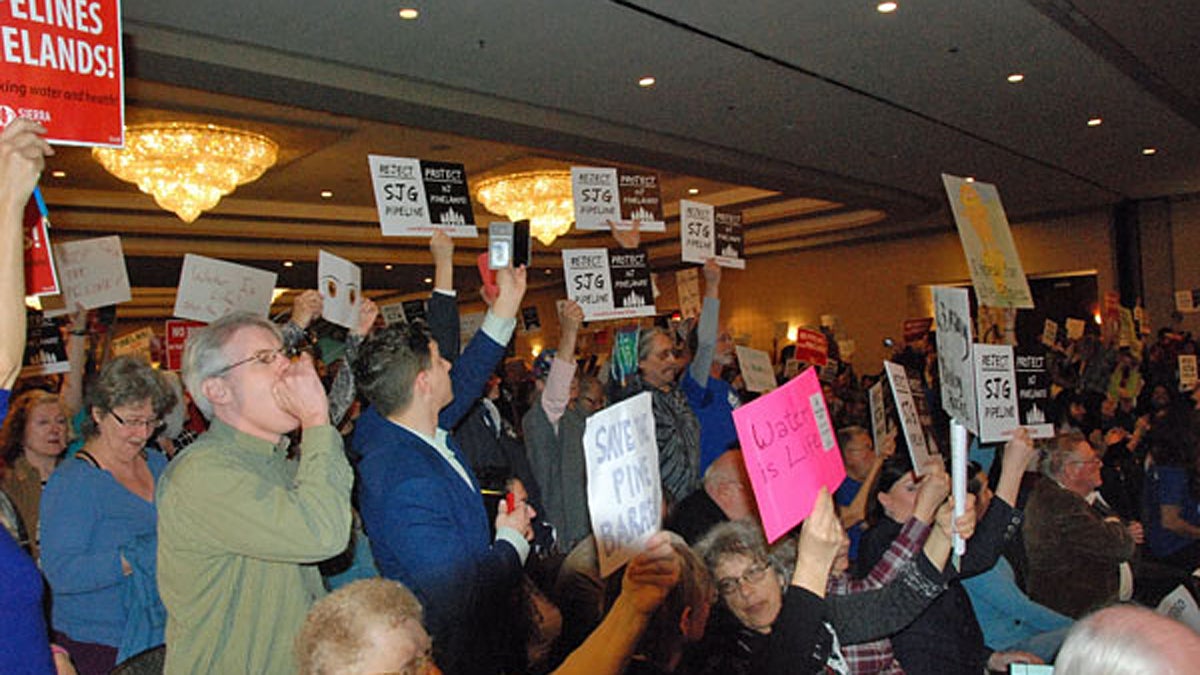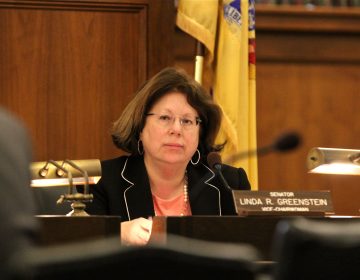What the legal arguments are for and against N.J.’s Pinelands Pipeline

Pipeline opponents make their feelings known at Pinelands Commission hearing. (Photo courtesy of Kirk Moore)
The New Jersey Pinelands Commission and its critics are heading back to the state appeals courts, after a tumultuous public session Friday in Cherry Hill where commissioners had to shout out their votes approving a South Jersey Gas pipeline route.
In the coming court challenge, project opponents will argue that the 15-member regional land-use and environmental board (Pinelands Commission) erred in finding the natural gas pipeline to the B.L. England power plant will “primarily” benefit Pinelands residents and businesses. That word is a decades-old criteria of the Pinelands management plan for allowing new infrastructure in the strictly regulated forest area, where the pipeline would traverse 10 miles on its 22-mile route to the power plant.
Stymied in earlier appeals, pipeline opponents are also questioning the project’s use of 24-inch diameter pipe. Approved for carrying 125,000 million cubic feet (MCF) of fuel per day, the pipeline, they said, would have twice the capacity needed to convert the 54-year-old coal- and oil-fired generating plant in upper Cape May County — and with upgrades, the potential to sell much more gas outside the Pinelands into the Shore region.
A ballroom at the Crowne Plaza hotel in Cherry Hill with a capacity of 1,500 was more than half full with jeering and cheering onlookers — some in support of the plan for the pipeline to repower the generating plant in upper Cape May County.
But the sign-waving crowd was overwhelmingly weighted toward opposition, and protestors disrupted the meeting for minutes at a time with chants, singing, and shouts.
Recommending pipeline proposal
Pipeline backers, including four commissioners named by Gov. Chris Christie and Pinelands counties after a failed 2014 vote on the project, provided a nine-vote majority amid voices from the roaring crowd. The approval was recommended in a formal report from the commission’s executive director Nancy Wittenberg, declaring that “the proposed project is in accord with the original vision” of the Pinelands land-use plan.
Environmental activists, who for months unsuccessfully sought to derail the pipeline application process right up to Friday’s gathering, went into it prepared to lose the vote, and fight the next battle before Appellate Division judges.
“If they approve it on the grounds that Nancy has given (in the report), we would appeal that,” said Carleton Montgomery, executive director of the Pinelands Preservation Alliance, before the commission met.
“The pipeline can carry vastly more gas than the power plant would use,” Montgomery said. Wittenberg’s report seemed to tacitly acknowledge that, with a proviso at the end that recommends “additional gas flow to the proposed 24 inch gas main or redirection of the proposed 125,000 MCF gas flow shall only be approved by a State agency if such approval is consistent with the standards of the Pinelands Comprehensive Management Plan.”
Five commissioners attempted to get the pipeline resolution tabled – and when that failed, they spoke in opposition, to cheers from the audience. Their objections were detailed by Commissioner Mark S. Lohbauer, formerly the commission’s chairman, until he opposed the pipeline and was turned out of the chairman’s position by Gov. Chris Christie in favor of current Chairman Sean W. Earlen.
Commissioner Mark Lohbauer read a statement from Commissioner Candace McKee Ashmun, an original member of the board since its founding in 1979. Ashmun recalled how the Pinelands plan was crafted at a time when state planners worried that offshore oil drilling — a possibility after the oil embargoes and price shocks of the 1970s — would lead to petroleum pipelines snaking westward from the coast across the forest to Delaware River refineries.
Now, Ashmun said, that scenario has reversed, with South Jersey Gas aiming to sell natural gas from hydraulic-fracturing well fields in Pennsylvania’s Marcellus Shale formation to Shore customers. The pipeline is “a way to get Pennsylvania natural gas to the coast,” and if approved would open the door for other utilities to likewise use the Pinelands as an energy corridor, she said.
A convenient route for industries
Ashmun and other original Pinelands planners worried about industries taking the Pinelands as a convenient route, and the development pressures that would follow, Lohbauer said.
“This is exactly the kind of lateral development” originating outside the Pinelands to deliver energy to the other side, Lohbauer said. “It will set a precedent for what is meant by ‘primarily serves the Pinelands.’” Any other utility can make the same kind of pitch for future projects, if the commission goes along with the pipeline plan, he warned.
Other commissioners favoring the pipeline said it was time to vote.
“I personally have enough information to make a decision,” said Vice Chairman Paul Galletta. Commissioner Alan Avery Jr., a longtime member who returned to the board three years ago, said since then “this issue has dominated… We have literally done very little else.”
The hotel ballroom scene capped a nearly five-year struggle by Houston-based Rockland Capital, its supporters in the Christie administration and Legislature, and business and labor allies to win permission for the high-pressure line from a South Jersey Gas facility in Maurice River Township to the B.L. England plant in Upper Township, on the south bank of the Egg Harbor River in Cape May County. Built in 1963, the coal- and oil-fired generating station faced permanent closure over its dirty coal emissions. Now it could get a new 20-year lease on life with conversion to gas.
The state Board of Public Utilities wants a rebuilt B.L. England as a regional power source after the Oyster Creek Nuclear Generating Station, located about 40 miles north up the Garden State Parkway, closes in 2019.
Pipeline backers from business and labor groups were heartened by the commission vote, but said they realize the fight is far from over. Supporters are anxious to see new jobs from the project, in a region battered by Atlantic City casino closings, prolonged construction and housing recession, and some of the highest home foreclosure rates in the state.
“They finally made a judgement on it. It isn’t over, but at least it got done,” said Fred Green, a business agent with UA Plumbers & Pipefitters Local 322. “It’s not about jobs, it’s about common sense.”
Green said pipeline supporters are not opposed to the solar and wind power advocated by environmental groups — he has rooftop solar at home.
“But in the scheme of things, with Oyster Creek closing, we need reliable power sources,” he said.
A plus for the region
South Jersey Gas officials promised the project will be an overall net benefit to the region.
“The careful construction of this pipeline will address the energy demands of 142,000 customers in Cape May and Atlantic counties, protect and create jobs, and provide a meaningful opportunity to significantly reduce air emissions while supporting the state’s Energy Master Plan,” the company said in a statement after the vote.
In densely populated New Jersey, energy planners and local governments are loathe to lose existing power plant sites and their future potential for energy, jobs, and tax revenue. At Oyster Creek, Lacey Township officials have expressed hopes the site could likewise one day host gas-fired generation.
Already Pinelands officials are considering another pipeline that New Jersey Natural Gas wants to extend through Ocean County to the west of Lacey. Conservation groups suspect the South Jersey Gas–B.L. England scenario could conceivably play out in Lacey too, with another future pipeline proposal through the Pinelands to the Oyster Creek site.
Keeping generation sites alive for future use “does have some advantages. The transmission lines, the fuel supplies, the (cooling) water are all there,” Frank Felder, director of the Center for Energy Economics and Environmental Policy at the Edward J. Bloustein School of Planning and Public Policy at Rutgers University, said in an interview.
“So it’s not surprising that people want to continue using these sites,” Felder said. “New Jersey uses a lot of energy, and can only get it from the west — the western side of the state, or Pennsylvania.”
When Oyster Creek closes, “that doesn’t mean you have to keep B.L. England,” Felder said. But there are regional and local implications.
“Not repowering means importing more energy from Pennsylvania,” with emissions from those generators generally drifting on prevailing winds into New Jersey. Locally, “there are always community concerns, employment concerns, emission concerns.”
Key positions in defense of pipeline
Pinelands Commissioner Wittenberg’s report staked out several key positions defending the pipeline against the coming court challenge. One deals with opponents’ argument that the pipeline would violate Pinelands rules that such forest-area infrastructure projects must benefit communities in the Pinelands.
While the B.L. England plant and most South Jersey Gas customers are outside the state-regulated Pinelands boundaries of roughly 1 million acres, they are within the Pinelands National Reserve — a broader area originally outlined by federal legislation in 1978 that laid the way for the state Pinelands Protection Act the following year, the report contends.
Commissioner Lohbauer countered that the gas-line route is exactly the scenario that Ashmun and other early Pinelands planners worried about — a pipeline originating outside the state-regulated Pinelands zones carrying hydrocarbon fuel to an end-user on the other side of the protected area.
Wittenberg cited earlier approvals for local natural-gas pipelines as precedents, including one for a 75-megawatt generating plant in 2004, and a 2011 permit for a gas line to the New Lisbon Developmental Center, the state Department of Human Services facility in Burlington County that cares for about 365 residents with intellectual and developmental disabilities.
“In the instance of the New Lisbon Development Center, the natural gas pipeline ran through the Preservation and Forest areas within the road rights-of-way,” the report stated, noting similarity to the South Jersey Gas plan to bury its proposed pipeline along existing roads.
“As the proposed pipeline was intended to serve the New Lisbon Developmental Center, it was found to serve the needs of the Preservation Area and as some of the route travelled through Forest Area the natural gas pipeline was similarly found to serve the needs of the Pinelands. There is ample precedent for findings of consistency with the primarily serves only the needs of the Pinelands standard for individual end-users, including residents and businesses and for electric generating facilities.”
Commissioner Richard Pritchett, another objector, disagreed with that analysis. Located in Pritchett’s hometown of Pemberton, the New Lisbon center uses all of the energy coming from its pipeline, and the same cannot be said for a repowered B.L. England plant that would be selling energy into the regional grid, he said.
Between the text of Wittenberg’s report to the commissioners, and the arguments of Lohbauer and the like-minded minority on the board, the next round of legal arguments appeared clear.
Janet Tauro, board chair of the environmental group Clean Water Action NJ, left a front row seat where she had demonstrated along with other activists during the raucous debate and votes.
“See you in court,” she quipped to reporters.
As if on cue, the crowd erupted again in chanting: “See you in court! See you in court!”
___________________________________________
NJ Spotlight, an independent online news service on issues critical to New Jersey, makes its in-depth reporting available to NewsWorks.
WHYY is your source for fact-based, in-depth journalism and information. As a nonprofit organization, we rely on financial support from readers like you. Please give today.




